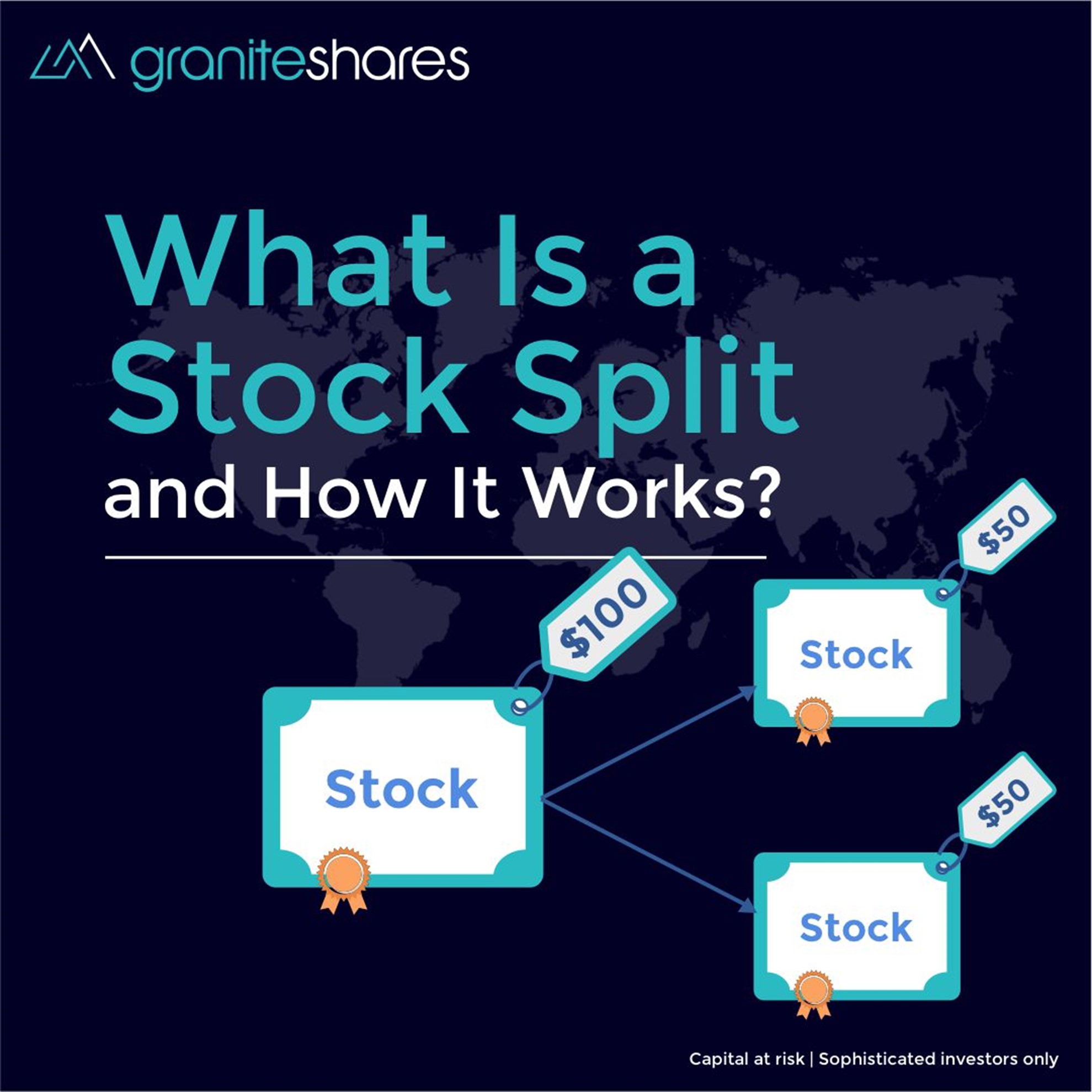What is a Stock Split and How It Works
Posted:
A stock split is a corporate action where a company divides its existing shares into multiple new shares to boost the stock's liquidity. Although the number of shares increases, the total value of shares remains the same because the split does not change the company’s market capitalization. Stock splits are usually expressed in ratios, such as 2-for-1 or 3-for-1, indicating how many new shares each existing share will be converted into. For instance, in a 2-for-1 stock split, each shareholder will receive an additional share for every share they own, effectively doubling the number of shares while halving the price of each share.
Understanding stock splits is essential for investors as they impact share price, market perception, and the number of shares owned. This article aims to demystify stock splits by explaining their mechanics, purposes, and implications. Additionally, it will provide a clear example to illustrate how stock splits work in practice, offering investors a practical perspective on this common yet often misunderstood financial event.
Understanding Stock Splits
Basic Concept
A stock split involves dividing a company's existing shares into multiple new shares. This action increases the number of shares outstanding while proportionally decreasing the price per share. Despite the increase in the number of shares, the overall value of an investor's holdings remains unchanged. For instance, in a 2-for-1 stock split, each shareholder receives one additional share for every share they own, and the price of each share is halved.
Reasons for Stock Splits
Companies may decide to split their stock for several reasons:
- Affordability: Lowering the price per share makes the stock more affordable to a broader range of investors, potentially increasing demand.
- Liquidity: More shares in circulation can enhance the stock's liquidity, making it easier to buy and sell shares.
- Psychological Impact: A lower share price can make the stock seem more attractive to investors, even though the company's market capitalization remains unchanged.
Post Stock Split Market Capitalization
Market capitalization is determined by multiplying the total number of outstanding shares by the current share price. For instance, if XYZ Corp. has 20 million outstanding shares, each trading at $100, its market cap would be $2 billion (20 million shares x $100).
If the board of directors decides on a 2-for-1 stock split, the number of shares would double to 40 million, while the share price would be reduced to $50. Despite these changes, the market cap remains the same at $2 billion (40 million shares x $50).
Forward Stock Splits vs Reverse Stock Splits
Forward Stock Splits
A forward stock split increases the number of a company's shares outstanding while proportionally decreasing the share price. This type of split is commonly implemented to make shares more affordable and attractive to a broader range of investors. For example, in a 2-for-1 forward split, each existing share is divided into two, effectively doubling the number of shares while halving the price of each share. Despite the increase in shares and the decrease in share price, the total value of an investor's holdings and the company's market capitalization remain unchanged.
Companies often use forward stock splits to improve liquidity and attract more retail investors by lowering the individual share price. This can create a positive perception among investors, suggesting that the company is confident in its future growth prospects. For instance, if a company with 1 million shares trading at $100 each announces a 2-for-1 forward stock split, after the split, there would be 2 million shares trading at $50 each, maintaining the company's overall market capitalization.
Reverse Stock Splits
Conversely, a reverse stock split decreases the number of a company's shares outstanding while proportionally increasing the share price. This type of split is typically used to boost the share price to meet stock exchange listing requirements or to improve the company's image. In a 1-for-2 reverse split, for example, every two existing shares are consolidated into one, reducing the number of shares and doubling the share price. Similar to forward splits, the total value of an investor's holdings and the company's market capitalization remain unchanged.
Reverse stock splits are often viewed as a strategy to prevent delisting from stock exchanges that have minimum share price requirements or to attract institutional investors who may have policies against buying low-priced stocks. While this can improve the perceived stability of the company, it may also be seen as a sign of underlying issues if the stock price had fallen significantly prior to the reverse split. For example, if a company with 2 million shares trading at $2 each announces a 1-for-2 reverse split, after the split, there would be 1 million shares trading at $4 each.
Why Do Companies Splits their Stock?
Increasing Affordability
One of the primary reasons companies engage in stock splits is to make their shares more affordable to a broader range of investors. As the share price decreases post-split, smaller investors who may have been deterred by a high stock price are more likely to purchase the stock. This increased accessibility can lead to a more diversified shareholder base and potentially higher demand for the shares.
Enhancing Liquidity
Stock splits can also enhance the liquidity of a company's shares. By increasing the number of shares outstanding and lowering the share price, it becomes easier for investors to buy and sell the stock. Higher liquidity can lead to narrower bid-ask spreads and smoother trading, which can be beneficial for both the company and its investors.
Positive Market Perception
A stock split is often perceived as a positive signal by the market. It can indicate that the company's share price has been performing well, which may suggest strong business performance and growth prospects. This positive sentiment can attract more investors and further boost the share price.
Meeting Exchange Requirements
In some cases, companies may use reverse stock splits to meet minimum price requirements set by stock exchanges. For example, if a company's share price falls below the minimum threshold required for listing on a particular exchange, a reverse stock split can increase the share price to maintain the listing. This helps the company avoid delisting, which can be detrimental to its visibility and investor confidence.
Is a Stock Split Good for Investors?
Stock splits can be beneficial for investors in several ways. Firstly, by lowering the price of individual shares, stock splits make the stock more affordable, allowing investors who were previously priced out to buy shares. This increased accessibility can broaden the shareholder base and potentially enhance demand for the stock.
For existing shareholders, a stock split results in owning more shares, though the total value of their holdings remains unchanged. The psychological benefit of holding more shares can be positive, even though it doesn't impact the fundamental value of their investment.
It's important to note that the strength and value of a company's stock are ultimately determined by its underlying financial performance and earnings, not the price of individual shares. While stock splits can improve market perception and liquidity, they do not inherently change the company's profitability or growth prospects. Therefore, while stock splits can be advantageous, they should be viewed in the context of the company's overall financial health and performance.
Stock Split Example
In 2021, NVIDIA Corporation announced a 4-for-1 stock split. Prior to the split, NVIDIA's share price was approximately $750, with about 500 million shares outstanding, giving it a market capitalization of $375 billion. (Source: Nvidia)
After the split, each share was divided into four, reducing the share price to around $187.50 and increasing the number of shares outstanding to 2 billion. Despite these changes, the market capitalization remained the same at $375 billion. This split made NVIDIA's shares more affordable to a broader range of investors without altering the overall value of the company.
Recently, on 22nd May, Nvidia announced a 10-for-1 stock split. Every common stock shareholder as of the market close on Thursday, June 6, 2024, will receive nine additional shares for one stock they hold, to be distributed following the market close on Friday, June 7, 2024. Trading is anticipated to commence on a split-adjusted basis at the market open on Monday, June 10, 2024. (Source: Nvidia)
Are Stock Splits Perceived as Good or Bad?
Stock splits are generally perceived as positive events in the financial markets. They often occur when a company's stock price has risen to a level where it might discourage new investors due to its high nominal value. By splitting the stock, the company makes its shares more affordable and accessible, potentially broadening its investor base and increasing liquidity.
Moreover, stock splits are typically seen as a signal of growth or anticipated future growth by the company's management, reflecting confidence in the company's financial health and prospects. The lower nominal share price post-split may attract new investors, driving up demand and potentially leading to an increase in the stock price. Overall, stock splits are regarded favorably as they signify growth, improve accessibility, and can stimulate investor interest and trading activity.
Bottom Line
Stock splits are generally perceived as positive events in the financial markets, signaling growth and making shares more accessible to investors. While they don't change the fundamental value of a company, they can broaden the investor base and increase liquidity. Ultimately, the impact of a stock split depends on the company's underlying financial health and performance.
NVIDIA ETPs by GraniteShares
| Product name | Ticker | ||
|---|---|---|---|
| USD | EUR | GBX | |
DISCLAIMER
Please note that GraniteShares' short and leveraged Exchange Traded Products are suitable only for sophisticated investors.
This is a disclaimer stating that all trading and investing comes with risks. Always do your research and do not invest more than you can afford to spend.
GraniteShares accepts no responsibility for any loss or damage resulting directly or indirectly from the use of this blog or the contents. GraniteShares Limited (“GraniteShares”) (FRN: 798443) is an appointed representative of Messels Limited which is authorised and regulated by the Financial Conduct Authority.
This blog does not constitute an offer to buy or sell or a solicitation of an offer to buy securities in any company. Nothing contained herein constitutes investment, legal, tax or other advice nor is to be relied upon in making an investment or other decision. No recommendation is made positive or otherwise, regarding individual securities or investments mentioned herein. Any summary list of risk factors does not purport to be a complete enumeration or explanation of the risks involved in a particular investment. Prospective clients must consult with their own legal, tax and financial advisers before deciding to invest. This email contains the opinions of the author and such opinions are subject to change without notice. The source of data is GraniteShares unless otherwise stated. No guarantee is made to the accuracy of the information provided which has been obtained from sources believed to be reliable. This email and the information contained herein is intended only for the use of persons (or entities they represent) to whom it has been provided. Past performance is not a reliable indicator of future results. The value of an investment may go down as well as up and can result in losses, up to and including a total loss of the amount initially invested. Investments may involve numerous risks including, among others, company risks, general market risks, credit risks, foreign exchange risks, interest rate risks, geopolitical risks and liquidity risks. Please note that GraniteShares short and leveraged Exchange Traded Products are for sophisticated investors.


